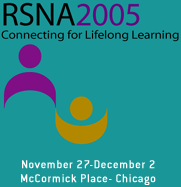
Abstract Archives of the RSNA, 2005
SSK04-08
Radiofrequency Ablation of the Lung: Staged Protocol Yields Larger Zones of Ablation in a Porcine Model
Scientific Papers
Presented on November 30, 2005
Presented as part of SSK04: ISP: Chest (Interventional Techniques)
Lynn S. Broderick MD, Presenter: Nothing to Disclose
Kevin M Fahey MD, Abstract Co-Author: Nothing to Disclose
Paul Laeseke, Abstract Co-Author: Nothing to Disclose
Chris L Brace MS, Abstract Co-Author: Nothing to Disclose
Lisa Ann Sampson, Abstract Co-Author: Nothing to Disclose
Fred T. Lee MD, Abstract Co-Author: Nothing to Disclose
RF ablation of pulmonary nodules presents a unique challenge because the inherent high impedance of surrounding aerated lung prevents high power deposition. The purpose of this study is to determine if a staged ablation protocol using shorter (3 minute) power applications interrupted by 2 minute generator “off” times can increase ablation zone size by increasing the amount of power deposited into lung.
RF lesions (n=36) were created in the lungs of 45 kg pigs (n=6) under fluoroscopic guidance using a single 17 gauge electrode (Cool-tipTM, ValleyLab, Boulder, CO). The conventional impedance-controlled pulsing algorithm was compared to a protocol in which RF application was interrupted by 2 min rest intervals (6 min vs. 2 x 3 min, 12 min vs. 4 x 3 min, 18 min vs. 6 x 3 min ablations). Animals were euthanized, lungs removed, and zones of ablation sliced at 3 mm intervals. TTC staining was performed to confirm cell death.
Zones of ablation sizes were greater for the interrupted vs. conventional protocol despite identical generator “on” times (Min diameter=2.4±0.7 cm, max diameter 3.1±0.8 cm (interrupted) vs. 1.9±0.5 and 2.6±0.5 cm (conventional), p=0.02 and 0.04 respectively). For ablation zones created using the staged protocol, the initial impedance after each rest period progressively decreased from the pre-RF baseline, which allowed greater power deposition in subsequent heating stages.
A staged RF ablation protocol results in larger zones of ablation in lung than the impedance-controlled ablation protocol, which has been optimized for liver.
F.T.L.: Fred Lee is on the Board of Advisors for Valley Lab
Broderick, L,
Fahey, K,
Laeseke, P,
Brace, C,
Sampson, L,
Lee, F,
Radiofrequency Ablation of the Lung: Staged Protocol Yields Larger Zones of Ablation in a Porcine Model. Radiological Society of North America 2005 Scientific Assembly and Annual Meeting, November 27 - December 2, 2005 ,Chicago IL.
http://archive.rsna.org/2005/4412435.html

